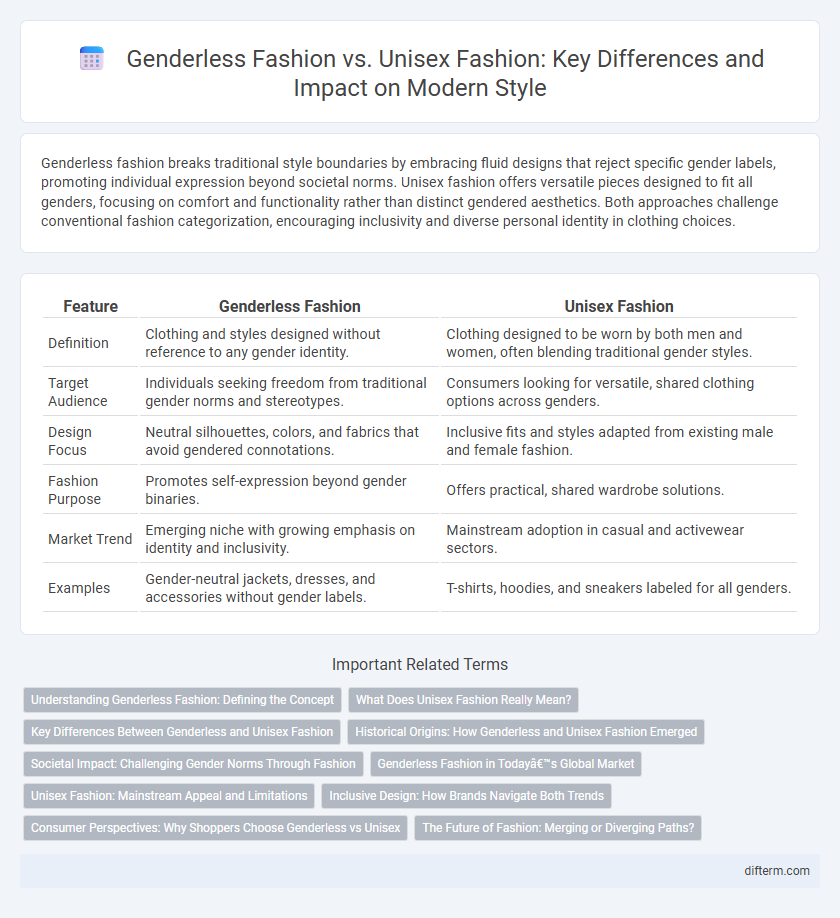Genderless fashion breaks traditional style boundaries by embracing fluid designs that reject specific gender labels, promoting individual expression beyond societal norms. Unisex fashion offers versatile pieces designed to fit all genders, focusing on comfort and functionality rather than distinct gendered aesthetics. Both approaches challenge conventional fashion categorization, encouraging inclusivity and diverse personal identity in clothing choices.
Table of Comparison
| Feature | Genderless Fashion | Unisex Fashion |
|---|---|---|
| Definition | Clothing and styles designed without reference to any gender identity. | Clothing designed to be worn by both men and women, often blending traditional gender styles. |
| Target Audience | Individuals seeking freedom from traditional gender norms and stereotypes. | Consumers looking for versatile, shared clothing options across genders. |
| Design Focus | Neutral silhouettes, colors, and fabrics that avoid gendered connotations. | Inclusive fits and styles adapted from existing male and female fashion. |
| Fashion Purpose | Promotes self-expression beyond gender binaries. | Offers practical, shared wardrobe solutions. |
| Market Trend | Emerging niche with growing emphasis on identity and inclusivity. | Mainstream adoption in casual and activewear sectors. |
| Examples | Gender-neutral jackets, dresses, and accessories without gender labels. | T-shirts, hoodies, and sneakers labeled for all genders. |
Understanding Genderless Fashion: Defining the Concept
Genderless fashion challenges traditional gender norms by offering clothing designed to transcend male and female categories, emphasizing individual expression and inclusivity. Unlike unisex fashion, which primarily merges men's and women's styles into a shared category, genderless fashion rejects binary distinctions altogether, prioritizing fluidity and personal identity. This approach fosters a broader cultural shift towards non-binary representation in fashion, influencing designers, brands, and consumers seeking alternatives beyond conventional gendered apparel.
What Does Unisex Fashion Really Mean?
Unisex fashion refers to clothing designs that are created to be worn by any gender without adhering to traditional gender-specific styles or cuts, emphasizing inclusivity and versatility. Unlike genderless fashion, which often challenges and blurs the concepts of gender norms altogether, unisex fashion maintains neutral aesthetics and functional designs that appeal broadly to all genders. This approach focuses on simplicity, comfort, and adaptability, making it a practical choice for consumers seeking style without gender categorization.
Key Differences Between Genderless and Unisex Fashion
Genderless fashion rejects traditional binary categories altogether, emphasizing fluidity and self-expression beyond societal gender norms. Unisex fashion offers clothing designed to fit all genders, often blending typical masculine and feminine styles into versatile, neutral pieces. Key differences include genderless fashion's focus on identity liberation versus unisex fashion's practical inclusivity in sizing and design.
Historical Origins: How Genderless and Unisex Fashion Emerged
Genderless fashion and unisex fashion both trace their origins to the 1960s counterculture movements challenging traditional gender norms. While unisex fashion primarily emerged as a practical approach to create clothing suitable for all genders, genderless fashion evolved as a deeper expression rejecting binary gender constructs altogether. Designers like Yves Saint Laurent and brands such as Rad Hourani played pivotal roles in popularizing these styles, reshaping the fashion industry's perception of gender identity.
Societal Impact: Challenging Gender Norms Through Fashion
Genderless fashion dismantles traditional gender binaries by offering clothing that transcends societal expectations, promoting individual expression without the constraints of male or female categories. Unisex fashion, while blending styles from both genders, often retains subtle elements tied to gender norms, whereas genderless fashion actively challenges and redefines these norms. The rise of genderless fashion contributes to a more inclusive and diverse representation in the fashion industry, encouraging a cultural shift toward acceptance and fluidity in identity.
Genderless Fashion in Today’s Global Market
Genderless fashion challenges traditional gender norms by creating styles that transcend male and female categories, fostering inclusivity and cultural diversity in today's global market. This approach emphasizes individual expression through versatile, non-binary collections that appeal to a broader consumer base seeking authenticity and fluidity in clothing. Brands adopting genderless fashion enhance market reach and drive innovation by blending aesthetics, fabrics, and silhouettes that defy conventional gender distinctions.
Unisex Fashion: Mainstream Appeal and Limitations
Unisex fashion embraces clothing designed to be worn by any gender, promoting inclusivity and simplicity in wardrobe choices, which has driven its mainstream appeal in contemporary fashion markets. Brands like Calvin Klein and TOM FORD have popularized unisex collections that challenge traditional gender norms through versatile cuts and neutral palettes. However, unisex fashion often faces limitations as it may not fully address the diverse fit and style preferences of all consumers, leading to compromises in comfort and individuality.
Inclusive Design: How Brands Navigate Both Trends
Brands embracing inclusive design strategically blend genderless fashion, which removes traditional gender binaries entirely, with unisex fashion that offers versatile styles for all genders. This approach involves creating adaptable silhouettes, neutral color palettes, and size ranges that cater to diverse body types and gender expressions. By integrating both trends, designers foster inclusivity while appealing to a broader demographic seeking non-restrictive and expressive clothing options.
Consumer Perspectives: Why Shoppers Choose Genderless vs Unisex
Consumers choose genderless fashion for its inclusive representation and freedom from traditional gender norms, appealing to those seeking self-expression without constraints. Unisex fashion attracts shoppers who prefer practicality and simplicity, as these styles offer versatile, easily shared wardrobe staples. Preference often hinges on individual values, with genderless designs emphasizing identity fluidity and unisex focusing on functionality and shared aesthetics.
The Future of Fashion: Merging or Diverging Paths?
Genderless fashion rejects traditional gender norms by creating designs that do not conform to male or female categories, emphasizing individual expression and fluidity. Unisex fashion offers a practical approach with clothing designed to fit all genders, often prioritizing comfort and simplicity. The future of fashion may see these paths merging as designers blend the fluidity of genderless styles with the accessibility and inclusivity of unisex apparel, redefining identity through versatile and boundary-breaking collections.
genderless fashion vs unisex fashion Infographic

 difterm.com
difterm.com